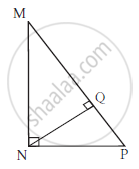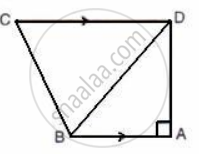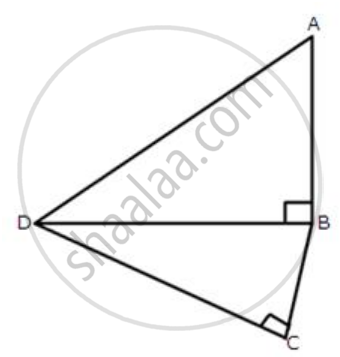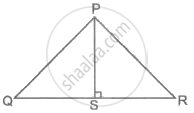Advertisements
Advertisements
Question
In figure AB = BC and AD is perpendicular to CD.
Prove that: AC2 = 2BC. DC.
Solution
Pythagoras theorem states that in a right-angled triangle, the square on the hypotenuse is equal to the sum of the squares on the remaining two sides.
We consider the ΔACD and applying Pythagoras theorem we get,
AC2 = AD2 + DC2
= ( AB2 - DB2 ) + ( DB + BC )2
= BC2 - DB2 + DB2 + BC2 + 2DB.BC ...( Given, AB = BC )
= 2BC2 + 2DB.BC
= 2BC( BC + DB )
= 2BC . DC
Hence proved.
APPEARS IN
RELATED QUESTIONS
ABCD is a rectangle whose three vertices are B (4, 0), C(4, 3) and D(0,3). The length of one of its diagonals is
(A) 5
(B) 4
(C) 3
(D) 25
A man goes 10 m due east and then 24 m due north. Find the distance from the starting point
In an equilateral triangle, prove that three times the square of one side is equal to four times the square of one of its altitudes.
Tick the correct answer and justify: In ΔABC, AB = `6sqrt3` cm, AC = 12 cm and BC = 6 cm.
The angle B is:
In ∆PQR, point S is the midpoint of side QR. If PQ = 11, PR = 17, PS = 13, find QR.
Find the length of the hypotenuse of a right angled triangle if remaining sides are 9 cm and 12 cm.
Pranali and Prasad started walking to the East and to the North respectively, from the same point and at the same speed. After 2 hours distance between them was \[15\sqrt{2}\]
km. Find their speed per hour.

In ΔMNP, ∠MNP = 90˚, seg NQ ⊥ seg MP, MQ = 9, QP = 4, find NQ.
In the figure: ∠PSQ = 90o, PQ = 10 cm, QS = 6 cm and RQ = 9 cm. Calculate the length of PR.
In the given figure, AB//CD, AB = 7 cm, BD = 25 cm and CD = 17 cm;
find the length of side BC.
The given figure shows a quadrilateral ABCD in which AD = 13 cm, DC = 12 cm, BC = 3 cm and ∠ABD = ∠BCD = 90o. Calculate the length of AB.
Diagonals of rhombus ABCD intersect each other at point O.
Prove that: OA2 + OC2 = 2AD2 - `"BD"^2/2`
If P and Q are the points on side CA and CB respectively of ΔABC, right angled at C, prove that (AQ2 + BP2) = (AB2 + PQ2)
In a triangle ABC, AC > AB, D is the midpoint BC, and AE ⊥ BC. Prove that: AC2 = AD2 + BC x DE + `(1)/(4)"BC"^2`
In a triangle ABC right angled at C, P and Q are points of sides CA and CB respectively, which divide these sides the ratio 2 : 1.
Prove that: 9AQ2 = 9AC2 + 4BC2
Sides AB and BE of a right triangle, right-angled at B are of lengths 16 cm and 8 cm respectively. The length of the side of largest square FDGB that can be inscribed in the triangle ABE is ______.

If S is a point on side PQ of a ΔPQR such that PS = QS = RS, then ______.
In ∆PQR, PD ⊥ QR such that D lies on QR. If PQ = a, PR = b, QD = c and DR = d, prove that (a + b)(a – b) = (c + d)(c – d).
In an equilateral triangle PQR, prove that PS2 = 3(QS)2.

If the hypotenuse of one right triangle is equal to the hypotenuse of another right triangle, then the triangles are congruent.
